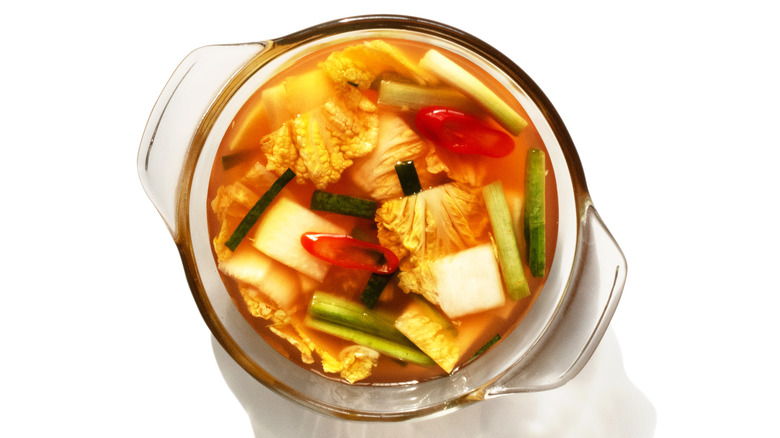Why David Chang Adds 7UP To His Kimchi Recipe
David Chang's ingenious method for making water kimchi, or mul kimchi, is by adding the easily-found 7UP drink. Chang first shared a recipe for water kimchi with Food & Wine, which he had learned to call "sparkling white kimchi," for Western audiences who only knew kimchi to be a spicy, red-sauced napa cabbage. As the hemisphere became more familiar with the various types, Chang decided to stand by the original name of the dish since water kimchi traditionally uses sparkling drinks anyway.
While 7UP isn't exactly traditional, soda water or cider is actually a common addition to kimchi in Korea. In modern water kimchi recipes, Koreans sometimes add Chilsung Cider (which is dubbed as the Sprite of Korea) to add extra fizz to their brine. Refreshing lemon-lime sodas like 7UP and Sprite add the perfect level of fizz that mimics the natural carbonation associated with fermented beverages while adding some necessary sweetness. Complementing the slightly sour, salty, and acidic flavors of kimchi, the light carbonation gives your mouth a refreshing vegetal bite.
Traditional mul kimchi vs. soda brine kimchi
For a classic mul kimchi made without soda, many recipes call for the addition of glutinous rice flour, or sugar and pear, which adds a fruity sweetness to the kimchi brine. These starches and sugars are mainly added to aid the fermentation process. Gas is produced in kimchi when lactic acid bacteria "digest" the sugars, turning them into carbon dioxide. In the traditional method, you would leave the cabbage to ferment in the brine you made with glutinous rice flour or sugar. While the process doesn't take too long, you do have to wait at least a day or two for the fermentation to be complete. The brine will taste tart, with a faint sweetness coming from the sugar, with a very light fizz.
David Chang's recipe calls for rapid pickling rather than fermentation. Chang covers the napa cabbage in salt and drains the excess liquid instead of using it as a base for the water kimchi. After an hour, he adds 7UP and vinegar to make the kimchi brine. When you compare this recipe to the age-old method of kimchi-making, you will find that Chang's method doesn't give you the natural tang and fizz that fermentation provides. Hence the need for an artificial tang with vinegar and effervescence from 7UP. But who says you need to use one method or the other? You can also incorporate a splash of 7UP in a fully fermented mul kimchi for some extra fizz.

